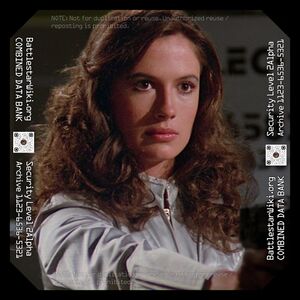- For subjects with a similar name, see: Aurora.
| |||||

| |||||
| Colony | Caprica | ||||
| Marital Status | Dating Damon | ||||
| Role | Shuttle pilot, Celestra | ||||
| Portrayed by | Ana Alicia | ||||
Aurora is a shuttle pilot aboard Celestra following the Battle of Cimtar.
Biography
editWhile Aurora's early life is unknown, she formerly had relations with Lieutenant Starbuck who, later, assumes that she was killed on Caprica during the Cylon Attack. Much to his surprise however, Aurora has been working on the electronics ship, Celestra, and has been listed in the Fleet's Computers as a shuttle pilot for Commander Kronus. When he attempts to reacquaint himself with her, she blows him off, correctly stating that if he had cared enough, he could have found her via the Fleet's Computers.
During the award ceremonies, Aurora gathers navigational information from Galactica on a nearby planet located somewhere in Beta sector so that she and her fellow mutineers, lead by her lover Damon, may settle there away from the Fleet. The impetus for this mutiny lie in the oppressive conditions imposed by Celestra's executive officer, Charka.
When Starbuck and Apollo just happen to thwart this mutiny, Kronus elects to take her and her compatriots to Galactica to personally oversee the dispensation of consequences. En route, however, the mutineers claim that they mutinied against him because of the oppressive conditions imposed upon them by Charka; they assumed he did so by Kronus' blessing.
When Celestra's guidance feed is terminated purposely (thus proving Charka's involvement), leaving the shuttle out into space unguided, the mutineers barter a deal: in exchange for a fair trial, they would enhance the sensors of the shuttle so they would be sensitive enough to detect Celestra's low power emissions.
During the endeavor, Damon has doubts as to whether or not Aurora would ever be satisfied with him. However, Starbuck convinces him that he is no obstacle between them, thus receiving her appreciation.
After retaking Celestra, she and her fellow mutineers are absolved of the mutiny charges (TOS: "Take the Celestra").
Notes
edit- Starbuck mistakes Cassiopeia for Aurora after awakening from decompression sickness, much to Cassiopeia's execration ((Comics: Battlestar Galactica: Cylon Apocalypse #1)).


